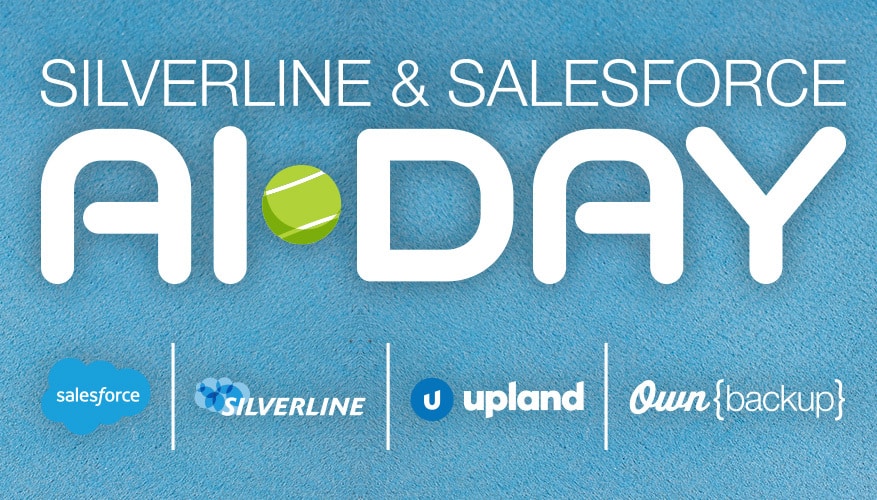On October 15, 2020, Salesforce hosted its Salesforce Industries Summit for Financial Services. After the day-long event, our FS leadership got together on a LinkedIn Live session to chat through what they learned. Read on to hear hot takes from the following Silverline experts:
- Geoff Merrick, SVP & GM, Financial Services
- Jill Harrison, VP of Silverline Ventures
- Fred Cadena, VP, Financial Services Strategy
- JP Owens, Director, Banking & Lending
We hope you enjoy the recap and are as excited about Salesforce Industries as we are. If you are interested in seeing the full conversation, you can watch it on LinkedIn.
What were the biggest things you heard and the highest level themes?
Geoff: You know, if I were to pick three, they would probably be speed, data, and then sort of digital/core. On the speed front, I heard over and over again that financial services firms and banks in particular, need to move faster than ever in this environment. I liked the focus on time to value. There’s oftentimes talk about time to market, but I liked the time to value is a little bit more emphasized today.
Since it’s all about maintaining the market speed and reacting to conditions, firms need to work with their environment and data. This is something we talk about all the time here at Silverline and it continues to be the critical piece. Lastly, the emphasis on digital and core. To paraphrase Chris Skinner, “If you’re not digital at the core and cloud native, then you’re not fit for today’s digital world of remote working.” So getting that right was certainly part of the messaging today.
Jill: We had seen that across the board this year with companies that have had to adjust versus companies that have a digital-first sort of culture embedded in their core. And luckily at Silverline, we’ve been doing the remote thing for awhile, so we’ve been happy to help anybody and everybody figure out how to adjust.
JP: I echo what Geoff said, what I heard in that first session was about more than a CRM. We talk a lot about how most of our first implementations are about getting the data right, and making sure you have your core CRM functionalities up and running. But then how do you expand and solve for certain business challenges — that’s where the speed and agility pieces come into play.
If you had already invested in that strong foundation and were using the platform correctly, it enabled you to do so much in the COVID environment to try to pivot and solve for certain challenges. We had a couple of clients do a lot of that rapid response who we worked to set up — and others now we’re trying to catch up and solve for it.
I think that’s going to be the big topic going forward into next year — making sure you have that foundation. And then you can do those engagement programs and take advantage of the cool things like the FSC community templates. So lots of opportunities to open up to think about how to use the system differently while keeping data at the forefront of that right foundation. From there, you put thought into your business architecture in addition to the features available with your CRM, which lets you get really strategic about solving business challenges.
Jill: You have been writing a lot about that this year too, haven’t you JP? That’s been a common theme you’ve been exploring.
JP: Yes. The last few months it’s been a lot of going back and thinking about how I started programs like this at my previous institution and just the business challenges that organically popped up. When we started solving for one thing, another and another would bubble to the surface. We had teams saying “We’ve got this challenge over here, and Salesforce worked over there. Maybe it can work in our department, too” and it organically gained momentum. The beauty of Salesforce is you can start to expand it and come up with different use cases to solve for. So it’s exciting.
Fred: One of the things that I found most exciting for being in the ecosystem as long as I have, is a lot more talk about unifying tool sets across the Salesforce platform.
Salesforce has made a number of tremendous investments, most recently (one of the biggest ones obviously being Vlocity) over the years and just bringing things together in a more unified way, thinking about how these solutions integrate more tightly together.
One of the most exciting things that came out of the Vlocity live session was a little bit of hint about how it is going to be used in other applications outside of insurance and financial services. I love the idea of integrating that tool set, data model, and other features so they are baked a little bit more succinctly into core. I mean, it’s already platform native. By bringing it more into the core, more into FSC, so more people can leverage it is going to be very powerful.
Tableau’s CRM, Experience Cloud, what are your thoughts?
Fred: It sort of reckons back to what I was saying about Vlocity. It’s the bringing of things together in a more unified way, and I’m really excited about Tableau CRM, and integrating Tableau as a larger part of the CRM workflow. There was a lot of talk about clarifying what the use cases are, where Einstein Analytics makes the most sense vs. where Tableau makes the most sense. I think that’s something that as we’ve been talking with our clients and our prospective clients has been a big question — how do I know when to use which?
This clarity coming from Salesforce makes it easier to integrate both tool sets together and it’s going to help companies accelerate their analytics use cases and drive a lot more value out of the data that they’re already collecting. Whether it’s in their CRM, through Salesforce, whether it’s part of their marketing package, whether it’s in their core data warehouse — wherever it sits, it’ll help make that data set a lot more actionable.
Jill: Right. And I think that after the nearly $16 billion acquisition last year of Tableau, it’s going to be pretty exciting to see what happens just generally with business intelligence.
First is sort of the blending together of Customer 360, which is Marketing Cloud and the marketing automation that you’re talking about, Fred and Datorama, and then customer 360 audience segmentation. How does that drive into Commerce Cloud enhancements, like the payment infrastructure that they’ve developed with Stripe and support individual wallet platforms like Google Pay and Apple Pay. And then how does that all blend together into an Experience Cloud kind of strategy?
And from what I can tell, Experience Cloud is really sort of the unification of Community Cloud individualized journeys, and sort of their content management system platform.
It’s the whole idea of an experience design builder that I think is going to be pretty compelling for customers that are really looking to develop experiences for their end users or for their clients. And I think that that’s going to be a really exciting development, especially for people that are wanting to actually transact and take payment, from their customers online.
Fred: We always talk about how Salesforce is great at branding and I really love the re-refocusing of Community Cloud into Experience Cloud. It really is about delivering digital experiences to all of the stakeholders, whether they are partners or customers. And I think things will be much more clear to the market which tool sets can be used for what needs.
There’s also been a ton of new innovation around the high velocity of sales platform — what does that mean for our clients?
JP: What I find interesting about what they have going on is again, the core foundational CRM items. Especially when you think about the COVID world where we’re not open as much in branches, where people aren’t coming in, or we’re not having as much physical engagement.
So we’re repurposing some of those full-time employees (FTE) that used to be in a branch, and now focusing on what their day to day looks like and how we can enable them to be more efficient.
And when you think about onboarding, managing your quality ratio, or addressing an at-risk customer — how do you want to engage them in an appropriate, effective way? High velocity sales has got some really interesting new tools that are coming out like the big digital meetings and ways to coach you through the next steps and put those cadences in. It opens up a lot of opportunity to repurpose and retool your FTEs to support the new normal, by trying to re-engage your customer base and make the most out of those engagements. And then with some of the voice analytics and other things they’re baking into it, it’s just going to be an awesome solution.
I think most people are going to start looking into it, especially as they evaluate how to keep everybody employed as much as they can by repurposing job functions and creating new strategies around optimizing their workforce.
Salesforce Industries for Financial Services is itself a new concept. What do you think that means for our clients?
Geoff: It is certainly exciting again, to have Vlocity under the tent and broadening the constructs that technology provides to be able to support many of the sub-verticals, (those that are near and dear to our heart and in your mind, you know, beyond financial services), but for national financial services.
But, as Fred mentioned before, unifying the tool sets and then bringing in some of the deep insurance experience and features, it’s truly one of the first times — if not the first time that you can talk full stack Salesforce. And that’s what customers are asking for.
What are the key takeaways on the compliant data sharing capabilities now?
Fred: It’s previously been one of those things that’s a kind of a multi-solution approach, some of which requires a lot of code. I just love the fact that this is going to be a unified way of doing it. It’s going to be very configuration-friendly. And so it democratizes as those rule sets have to change, not having to go in and do a lot of Apex modifications and that sort of thing. It brings compliance data sharing into the Salesforce philosophy of clicks, not code really being a lot more business friendly. More time to value with less spend is always a good way to go.
JP: I think the biggest thing that I took away from it is that now the conversation is easier because our clients can visualize it. So as they’re coming in new to the platform and they have these concerns, the fact that it’s a solution you can get your hands on and see demos of it, it’ll definitely make it an easier process for upfront discovery and scoping out what needs to be solved for in a project.
Jill: It’s also not just solving for the immediate need, but one of the things that I took away from their discussion today was it also provides the front end for really strong workflow processes. It addresses compliance and the front middle back office paradigm, which is a very compelling reason to bring forward those compliance processes into Salesforce and ease the burden on staff. Employees can see things more clearly in terms of who is active and has access to different records. Compliance people will be able to run reports and do event monitoring around when those things change. It’s a really compelling win for a lot of clients that are just starting to scratch the surface with compliance.
Now, onto the Actionable Relationship Center. What is it and why does it matter?
Geoff: One thing I know is I’m going to be hearing ARC in my sleep for the next however many months.
It’s some really great stuff — being able to understand your customers and who they are. There’s a famous quote from Lou Platt, who is the former CEO of Hewlett Packard and he said something along the lines of, “if only HP knew what HP knows, we’d be three times more productive.”
A big part of knowledge is relationships. And as a consulting organization it’s also a relationship business. You need to know your client needs and you need to know who else knows them. You need to know everything about them. And this is a really, really big step into truly knowing your customers and being able to reach them and understand all the different touch points.
Fred: This goes right to what I think is the one of the biggest asks I always hear when talking with clients and end users. “So we started doing user workshops as I want to be able to have the CRM, tell me what’s important. What should I focus on right now?” And ARC provides an interface that’s designed to surface all the data that’s in Salesforce, leveraging what’s sitting in external systems, and uses analytics to surface up those most important connections, those most important next steps.
It lets you know where the white space is, what the most valuable phone call you can make next to move your business forward. And that’s the game changer.
JP: It’s nice to see improvements to what was already there. I think what was there was great prior to this, but this just takes it a step further. And one of the main use cases I see where it would be of higher value is where you have those more complex commercial or business relationships.
You’re really trying to identify ownership levels and thinking about cross-sell opportunities for private banking or wealth management, and engaging them and making sure things are front and center for the right people at the right time. It looks like it’s going to have some interesting use cases to help make that a more relevant next step or data indicator for the people engaging in the platform.
Finally, we get meeting notes in Salesforce. We’ve been singing this song for awhile.
Geoff: Yeah. So happy to see it come to fruition, but I hate to tell you, I’m going to call them reports.
Fred: You’re probably not alone there, Geoff.
JP: I see lots of people using this going forward, whether it’s upgrading to this or bringing it into their process. It’ll definitely be a big value add to make the process easier to complete. I mean, it’s one of those things that people hate doing, but businesses cannot survive without them. And it drives so much workflow like who’s talking to who, who’s interested in what products, and who’s doing follow ups.
It really is delivering on the commitment that Salesforce made when releasing Financial Services Cloud, which is to continue to build more and more financial services use cases into the core product. And it’s great to see it finally on the platform
Jill: I’m really interested to think about the mashup of something like meeting notes and the relationship center, so you can look at and navigate your relationship while you’re preparing for a meeting or logging a meeting. There’s going to be an interesting sort of connection point between all of these things that I think will be really powerful for a lot of the bankers that we work with.
What were the hottest ‘hot takes’ from what you saw for your lines of business?
Jill: In capital markets, all this stuff is so relevant, you name it: the relationship management, the meeting notes, the compliant data.
Yes, we could build them ourselves, but this just makes it way easier. And I think that Salesforce has really shown a commitment to the capital markets, investment banking space. It’ll be super interesting to see not just the productivity uplift for those organizations, but also as those needs are met, how will they be used in their counterparts in mortgage lending or commercial banking or treasury management? A lot of the organizations that we work with have so many lines of business that can take advantage of these features.
Fred: I think it makes a lot of sense and I’ll just dovetail onto that from a wealth perspective, because I think there’s a lot of overlap in the need for exactly that toolset as well. From a wealth perspective, I can’t wait to see those come out. Especially as I think about some of our clients that have a diverse group of businesses, like some of our larger banks and larger financial services firms that are operating across wealth and banking and corporate banking. To be able to start performing these tasks and using these tools with less complexity and more customization is going to be great.
From an insurance standpoint, we’ve been Vlocity partners for over two years and we know it’s a great tool set. Seeing that becoming more front and center in Salesforce’s go to market, with the ability to take middle and back office functions, and move them on platform in a meaningful way for businesses that makes sense provides engaging front ends for those insurance companies that want to leverage both their their existing legacy systems and the Vlocity tool set is really something.
So whether you’re looking to speed the underwriting process or create more rule sets so you can achieve a higher degree of straight through processing, whether it be through underwriting or through claims — definitely look into how you can leverage the Vlocity tool set.
JP: I think we covered everything for the most part, but the one thing I will mention is the Ellie Mae plus Salesforce connector, that’s coming soon. I know we didn’t see a lot about it today, but they did announce that it is coming. So we’re staying very close to that to make sure we understand how that’s going to impact a lot of our clients and prospects, because mortgage is a very hot topic right now, things are moving very fast. Rates are very low, margins are thinner than ever. So how do we make this as efficient as possible to get people through the process and ideally cross sell them and engage them as a longer term client.
Interested in how our financial services team can help your team master Salesforce Industries for Financial Services? Reach out.




